Self-Adhesive Clear Pickguard Material
Wet and dry techniques for installing Self-Adhesive Clear Pickguard Material.
Warning:
The adhesive on this plastic pickguard material is very sticky. If you do not have experience working with this product, it is advised that you practice on a not so important instrument first, or seek the help of a professional luthier. Removal can be difficult, and finish damage is always possible!
Application temperature:
Ambient temperature should be 50 degrees F. (10 degrees C.) or above.
Dry installation:
Clean and dry the application surface. Peel the backing film down 1" from the top, and fold and crease the backing paper. Align the plastic and apply it, starting at the top, using firm strokes with a plastic squeegee, stiff cardboard or a soft cloth. Continue to remove the backing paper and smooth out the plastic with the squeegee. If air bubbles form, puncture them and smooth them out.
Wet installation:
Clean and dry the application surface. For best results, prepare a wetting solution (2 to 3 teaspoons of Windex® or liquid detergent in a gallon of water), or use plain water. With the pickguard mateiral face down, remove the backing film slowly. Using a sponge, flood the application surface and the adhesive-coated side of the plastic. Position the plastic and squeegee it from top to bottom, using light overlapping strokes. Dry the entire area with a clean cloth, and squeegee again with firm strokes, working from the center outward toward each edge. Squeegee again after 24 hours. Ultimate adhesion will occur 24-48 hours after application.
Cleaning:
Use a detergent solution or mild soap and warm water, and a soft cloth. Certain types of dirt and grease may need to be removed with mineral spirits or naphtha.
Removal:
Inserting a sharp knife or razor blade under a corner and peeling carefully should let you remove the plastic in fairly large strips. Most of the residue can be removed by lifting it with the adhesive side of the removed plastic. If this is unsuccessful, soak the residue with a mild solvent such as naphtha. Make sure not to damage the finish of the instrument. Try out the solvent in an inconspicuous spot.





